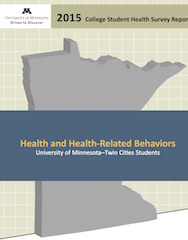Report Examines Gender Disparities in College Student Health
Posted on Jan 06, 2016 | Comments 0
 The University of Minnesota Twin Cities has released a new report on the health behaviors of its large student body. The university enrolls more than 34,000 undergraduate students and nearly 17,000 graduate students. Women are 51 percent of the undergraduate student body.
The University of Minnesota Twin Cities has released a new report on the health behaviors of its large student body. The university enrolls more than 34,000 undergraduate students and nearly 17,000 graduate students. Women are 51 percent of the undergraduate student body.
The report examines the behaviors of students relating to tobacco, alcohol, nutrition, physical activity, sexual activity, and other health measures. There are several indicators relating to gender that are of interest:
- Almost all students were covered by health insurance but women were more likely to be uninsured than men.
- Some 58 percent of women said they had a medical examination in the previous 12 months compared to only 42.6 percent of men.
- More than four out of five women students had been to the dentist over the previous 12 months compared to 75.8 percent of men.
- More than 23 percent of women students had suffered from depression in their lifetime compared to 16.2 percent of men.
- Some 5.8 percent of all women students had been diagnosed with an eating disorder. For men, 1.2 percent had been diagnosed with an eating disorder.
- More than 15 percent of women were taking medicine for a mental health condition compared to 8.7 percent of men.
- Some 20.5 percent of male students reported tobacco use compared to only 8.9 percent of women students.
- While overall alcohol use rates were similar, women reported an average of 3.5 drinks per week compared to an average of 6.0 drinks per week for male students.
- Nearly one quarter of all women students reported using marijuana over the previous 12 months. For men the marijuana use rates was 31.8 percent.
- Nearly 9 percent of women students said they had been a victim of a sexual assault during the previous 12 months.
- More than 12 percent of women students said they had been a victim of domestic violence within the previous 12 months.
- More than 6 percent of male students said they had been involved in physical fight over the previous three months. For women, 2.4 percent had been in a fight.
Filed Under: Research/Study








